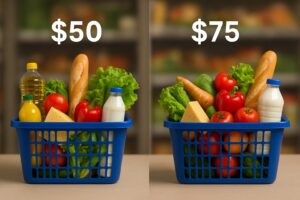What To Do If Your Expenses Go Up But Your Income Doesn’t

Many families today face a common problem: prices for everything keep going up, but paychecks stay the same.
From higher grocery prices to bigger utility bills, the cost of living can rise faster than your income, making it harder to stay on budget. Knowing why this happens and what steps to take can help you stay in control and avoid falling into too much debt.
WHAT YOU SHOULD KNOW:
- Costs are rising for many things like food, housing, utilities, and gas.
- If your income doesn’t grow, you need a plan to make your money last.
- Using credit cards to fill the gap can lead to more debt.
- Making small changes now can help you get back on track.
Why Expenses Rise Faster Than Income
Prices often go up over time. This is called inflation, and it means your money buys less than it used to. Basic needs like rent, groceries, and gas have all gotten much more expensive in recent years.
Sometimes, costs jump suddenly. Your rent may go up, your car insurance could increase, or your electricity bill might be higher in the summer or winter. Even small increases add up, and without extra income, it can be hard to cover everything.
When this happens, some people use credit cards to pay for groceries, gas, or other daily expenses. Over time, this can create more debt and make the problem harder to solve.

The Risks Of Spending More Than You Earn
If your expenses stay higher than your income, you might face:
- More credit card debt
- Lower chances of getting approved for loans
- Late or missed payments that hurt your credit
- Little or no money for savings
- More stress about your finances
The greater the gap between what you earn and what you spend, the harder it can be to fix.

Understanding Your Budget
The first step to solving this problem is to know exactly where your money goes. A clear budget gives you control and helps you see where changes can be made. Break your spending into three main parts:
Fixed Costs
These are bills that stay about the same every month, like rent or mortgage, car payments, insurance premiums, and loan payments. Fixed costs are the largest part of a budget and can be difficult to change quickly. However, you can still look for savings by refinancing a loan, searching for better insurance rates. Reducing even one fixed cost can free up money for some other need.
Variable Costs
These are expenses that change from month to month, such as groceries, gas, utilities, and entertainment. Since these costs can go up or down, they give you more flexibility to adjust your spending.
You might cut grocery costs by buying in bulk, planning meals ahead of time, or switching to store brands. For utilities, small changes like turning off unused lights or adjusting your thermostat, or investing in a can make a difference over time.
You can also look for ways to replace monthly charges with one-time purchases. For example, investing in a Wi-Fi extender could improve your internet signal throughout your home without having to pay your provider an extra monthly fee for a stronger connection.
Extra Spending
This category covers non-essential items that make life enjoyable but are not necessary for your daily needs. Examples include eating out, streaming services, shopping for clothes, hobbies, or travel.
Trimming these costs does not mean giving them up completely. You can set a monthly limit for “fun money” so you can still enjoy treats without hurting your budget.
Track your spending for at least a month is the best way to see where your money is really going. You can use a notebook, a spreadsheet, or apps like Mint, Goodbudget, or YNAB (You Need A Budget).
Simple Ways To Close The Gap
If costs are going up but your paycheck isn’t, here are some ways to balance your budget.
1 – Spend Less Where You Can
- Eat more meals at home instead of dining out.
- Cancel subscriptions you rarely use.
- Buy store-brand items instead of name brands.
2 – Bring In More Income
- Look for extra work, like driving for rideshare services or babysitting.
- Ask for extra hours at your current job.
- Sell items you no longer need online or at a yard sale.
3 – Handle Debt Carefully
- Pay off the highest-interest debt first.
- Look into balance transfer offers to save on interest.
- Ask a debt relief company for help if payments are becoming too hard to manage.
Adding Proactive Income Strategies
Beyond short-term fixes, think about ways to steadily increase your income over time.
This might mean learning new skills, taking a course that can lead to a higher-paying job, or starting a small side business that grows each year.
Even small, steady increases in your income can help you keep up with rising costs, pay off debt faster, and build a stronger safety net for the future.
How Debt Relief Can Help
When you have to use credit cards just to get by, the balance can grow fast. Debt relief programs work with your creditors to reduce what you owe.
This can lower your monthly payments and help you pay off debt sooner.
Benefits of debt relief include:
- Owing less money overall
- Lower monthly payments
- Becoming debt-free faster
- Avoiding bankruptcy
Always choose a trusted, accredited company that clearly explains your options.
Protecting Your Money And Credit
When your budget is tight, it’s important to avoid choices that could make things worse.
- Keep credit card balances below 30 percent of your limit.
- Stay away from payday loans or high-fee products.
- Check your credit report regularly to make sure it’s correct.
A Real-Life Example
Imagine someone earning $75,000 a year whose rent, utilities, groceries, and other costs go up by $1,000 each month.
Plus, they start using credit cards for other expenses as well… and soon end up with just over $20,000 of credit card debt alone.
By joining Americor’s debt relief program, they are able to reduce their debt to around $10,000 and pay it all off in less than three years.
Once the debt is gone, they can use that money for savings instead.
Taking The First Step Toward Stability
When expenses rise but income does not, it can feel like you are fighting a losing battle.
However, with careful budgeting, proactive income strategies, and the right professional help, it is possible to regain control and avoid long-term debt.
At Americor, we understand the unique financial challenges people are facing today.
As America’s trusted source for debt relief solutions, we aim to empower you with financial knowledge that can lead to informed decisions, whether it’s about savings, investments, or managing debt.
If your debt has become unmanageable and you have difficulty making your debt payments each month, then you should consider a free consultation call with one of our certified Debt Consultants, who can provide personalized advice tailored to your specific needs.
By taking proactive steps today, you can put an end to your financial stress and work towards a brighter financial future.
Remember, there is always hope for debt relief, and our team of experienced professionals are ready to guide you on your journey to regaining control of your finances.
For more information on Americor’s debt relief services, contact us today to see how we can help you eliminate your debts, and get on the fast-track to becoming completely debt-free!
